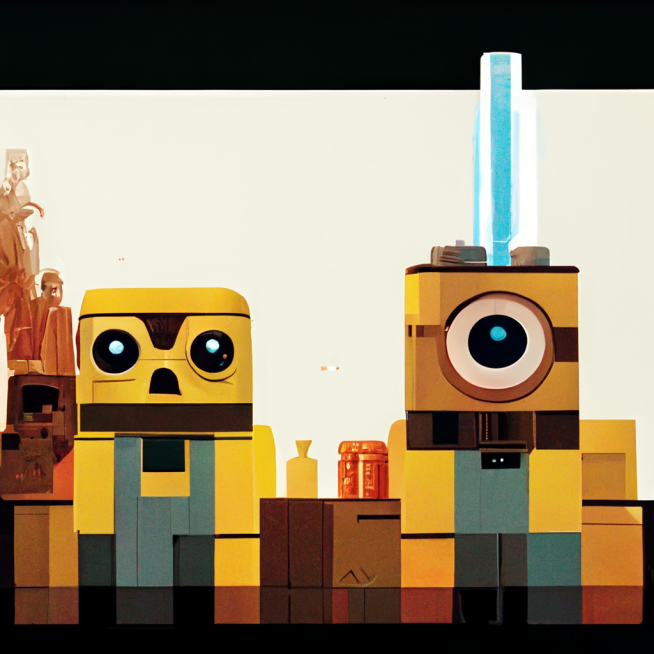We’re only a month into 2023, and it somehow feels like we’ve been transported to the future. Seemingly overnight, hundreds of artificial intelligence (AI) tools have burst onto the scene. My newsfeed and social media are blowing up with people drooling over what they are capable of.
Of course, this is not an overnight innovation. Many of these tools have been available for a while now. They are just finally becoming useful enough to enjoy the spotlight. So what does it mean for digital agencies now that there is an arsenal of new tools to supercharge your productivity? In a word - transformation. The agencies that are successful five years from now will be the ones that learn to leverage AI tools to gain a competitive advantage.
I see two main reasons for agencies to embrace AI technology
To improve efficiency & productivity. AI tools can automate many time-consuming and labor-intensive tasks, allowing agencies to work more efficiently and effectively.
To offer new products and services, effectively competing with bigger agencies. Smaller agencies often have to outsource things that their in-house team lacks the skillset for. AI tools can allow your existing team to take on new challenges by allowing AI tools to do part of the work before having a professional step in and get it over the finish line.
1) Improving efficiency & productivity
Research
Let's start with the research aspect. Gone are the days of spending hours combing the internet for information. With AI tools all you have to do is input a topic, and it will provide all the information you need to jumpstart your research. This saves you time and may uncover an angle or connection you wouldn’t have discovered on your own.
It should be noted that the tool currently dominating the news is ChatGPT, a state-of-the-art natural language generation system that can generate text from a prompt. However, it is not perfect and has several limitations. For example, it often produces generic and repetitive content, and its output can be hard to follow due to its lack of coherence and structure. Additionally, ChatGPT cannot produce content requiring domain-specific knowledge, as it does not consider any prior contextual knowledge. Finally, as it is only a text-generation system, it cannot produce visuals or audio, making it unsuitable for multimedia content. Check out this article for the latest and greatest ChatGPT alternatives.
Copywriting
Supercharge your copywriting department & free up your writers' time to work on strategic work that only they can do. Imagine generating high-quality text content in minutes, from blog posts to product descriptions. And best of all, having AI create an outline will often be enough to kick writer's block to the curb. The copy generated by AI tools such as ChatGPT and Writesonic will need to be revised by your team to ensure correctness and brand tone of voice and to add the writer’s own flair. But it will dramatically reduce the time it takes to create a given piece of content, freeing your writers up to work on the parts of writing that they actually enjoy.
Design
The benefits of AI aren’t limited to saving time and effort. AI tools also enable more creativity in the design department. With AI-based image generators like DALL-E and Midjourney, you can create an image of just about anything you can imagine. At the end of the day, your design team will still need to create the final product, but you’ll have a greater chance of giving the client what they want if the designers can quickly and efficiently iterate on an idea. And better yet, these tools enable non-designers to convey their ideas visually which improves collaboration across departments. The results can be hit-and-miss, ranging from completely stunning to the stuff of nightmares. But if your initial prompt doesn’t produce the desired result, you can simply revise your prompt, and an alternative will be produced within minutes.
I wanted to test how accurately an AI imaging tool could bring a creative vision to life. So I enlisted the help of my kids, both of whom have wild imaginations. I asked them to devise Midjourney prompts for a crazy image they’d never seen before. My daughter's prompt was “a frog with horns and mustache,” and my son’s was “Minecraft with Minions and Luke Skywalker and robots.”
I find the resulting frog image to be strangely beautiful. It’s bizarre and unearthly, but I genuinely like it.
As for the other image, I was blown away by the fact that I really could see the elements of Minecraft, Minions, and Star Wars. I don’t personally see anything related to robots. But this image is a great example of how you can use an AI imaging tool to help convey a fairly abstract idea.
Coding
As your agency scales, it’s likely that you will need to outsource software development from time to time. But your internal team is still responsible for reviewing and testing the code to ensure it’s up to snuff. We’ve all experienced frustration when presented with poorly commented code. It can take hours of work for a developer to understand what another developer has created. Unless, of course, they use a tool like Stenography, which reads code and adds the comments. This can be an invaluable tool for understanding code and for developers to discover where they can improve their own comments.
If you are an agency that uses Figma for design, you may want to introduce your developers to Pygma. This tool turns Figma designs into high-quality code and currently works with HTML, CSS, and React, with more options on their roadmap.
And when it comes to debugging, even the best devs have found themselves truly stumped and stuck in debugging limbo. So it should come as no surprise, that developers have already found some creative workarounds to get AI tools to debug their code.
Spreadsheets & Custom Dashboards
I am a complete data nerd and use many spreadsheets in my daily tasks. Whether I’m running a financial report, or comparing utilization to predicted work, I invariably end up wanting to see the data in a way that is complicated to create. This means I inevitably end up online researching which combination of equations to use. But then I found Excel Formulator. You simply choose what application you’re using (Excel, Sheets, or Airtable) and use plain English to describe what you want to do. And voila, the tool spits out the calculation. I’m a big fan of this tool, as it has saved me countless hours of figuring it out on my own.
Presentations
For years, Microsoft’s Powerpoint has had a “Quick Starter” functionality where it puts together an outline for a topic of your choosing and recommends areas to research further. Their built-in search function allows you to search the web for images and articles from your presentation. Given Microsoft’s recent 10 billion investment in OpenAI, I expect this feature to quickly gain in both popularity and usefulness.
2) Offering new products and services
The average client wants to work with as few vendors as possible. So what additional products and services can you offer your existing clients by leveraging AI tools? Can you take on more copywriting or digital marketing using your current team? Can you help your clients to create promotional materials, training videos, or custom videos and audio?
AI-based voice generation tools can create unique and professional-sounding audio in any language without the need to hire voice actors. And with AI-based music generation software, agencies can create unique soundtracks and background music for videos, podcasts, and other multimedia projects. I tried a tool called Aiva AI to make a custom theme song for a set of videos I’m creating, and I think the final result is pretty impressive.
Video creation using human avatars is an area, where I expect to see a lot of growth over the next few years. Especially for organizations that traditionally spend a lot of money on training/explainer videos. With text-to-speech technology, you can create videos in multiple languages without any extra effort. This is done by using text-to-speech technology, which can convert written text into spoken words in any language. This means that agencies can create training videos in multiple languages without the need to hire actors or pay for translation services by using tools such as Hour One or Synthesia. At this point, nobody is going to mistake these avatars for real humans, but I expect that over time the technology will improve to the point that they are virtually indistinguishable from a live presenter. If you want to see this type of technology in action, check out this video created by Hour One, which gives their predictions for 2023.
We are just scratching the surface of what’s possible with AI. So give some thought as to where the inefficiencies are in your agency, then check out this list of over a hundred AI tools available today and start playing around with them to find out which ones are a good fit for your workflow.
Looking to the future
In the short term, we can expect to see substantial improvements to existing tools. Within the next couple of years, we can expect an explosion of more advanced and sophisticated AI tools, many of which haven’t even been dreamt up yet.
One area of particular interest is video AI, which has the potential to revolutionize the way agencies create and edit video content. Creators will be able to edit and enhance videos and animations and add special effects automatically. We should also expect voice-to-video AI to become mainstream, drastically reducing production and animation time. Other possibilities include AI-based tools for creating interactive AR/VR experiences and AI-powered virtual assistants that can help with project management and client interactions.
We should also expect much debate and likely some legislation around how AI will be permitted to be used. There are valid concerns regarding ethics, privacy, misuse, and job displacement. But while there is much we need to learn about artificial intelligence and its appropriate use cases, I’m quite confident that this technology is here to stay.
So don’t get left behind. Embrace the future, determine which AI tools will help boost your agency to new heights, and leave the competition in the dust.



